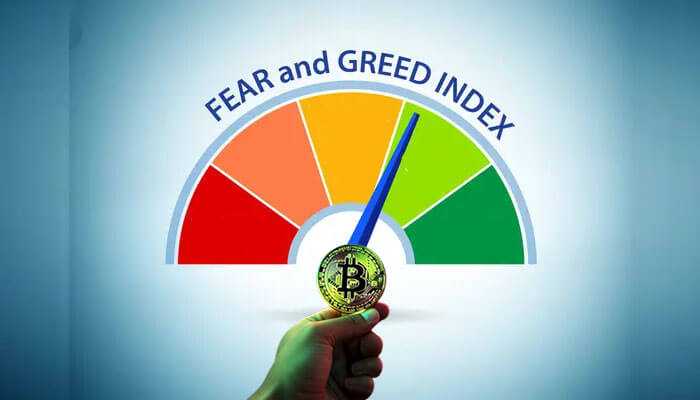One of the most important things that investors need to keep in mind in the constantly changing world of cryptocurrency trading is market sentiment. Comprehending the feelings that motivate market players may offer significant perspectives on possible fluctuations in price and help traders make well-informed choices. The Crypto Fear & Greed Index is one instrument that has grown in popularity among cryptocurrency traders for gauging mood in the market. We’ll explore the Crypto Fear & Greed Index’s definition, significance, calculation method, and practical applications for traders in this beginner’s tutorial.
What is the Crypto Fear & Greed Index?
The Crypto Fear & Greed Index, often referred to simply as the Fear & Greed Index, is a metric designed to measure the sentiment of cryptocurrency markets. It provides a snapshot of the emotions prevailing among market participants, specifically focusing on fear and greed. The index ranges from 0 to 100, with lower values indicating extreme fear and higher values indicating extreme greed.
Why Measure Fear and Greed in Crypto Trading?
Emotions that dominate market activity are fear and greed. A downward price spiral might result from investors panicking and selling their investments out of fear. On the other hand, if greed consumes an investor, irrational exuberance may result, in pushing prices to unaffordable heights. A trader’s ability to gauge market mood and predict future moves can be enhanced by assessing greed and fear.
Key Components of the Fear & Greed Index
The Fear & Greed Index considers various factors to assess market sentiment. By analyzing these components, the index provides a comprehensive view of the emotions driving the market. Here are the key components of the fear & greed index:
1. Volatility:
Volatility is a measure of the magnitude of price fluctuations in the market. High volatility often accompanies periods of fear or uncertainty, as investors react to news and events with heightened emotions. The Fear & Greed Index considers volatility as a key component in assessing market sentiment, with increased volatility indicating higher levels of fear.
2. Trading Volume:
Trading volume refers to the total number of shares or contracts traded in a given market during a specific period. High trading volume suggests increased market activity and can be indicative of strong investor participation. The Fear & Greed Index takes into account trading volume across various cryptocurrency exchanges to gauge investor sentiment.
3. Social Media Sentiment:
Social media platforms like Twitter, Reddit, and Telegram are popular channels for discussing cryptocurrency markets. The Fear & Greed Index incorporates sentiment analysis of social media posts related to cryptocurrencies, capturing the collective mood of investors and traders online. Positive or negative sentiments expressed on social media can influence market sentiment and contribute to shifts in the Fear & Greed Index.
4. Market Momentum:
Market momentum measures the rate of change in the price of a security over time. A strong upward or downward momentum suggests that the market trend is likely to continue in the same direction. The Fear & Greed Index considers market momentum as a factor in assessing sentiment, with strong upward momentum indicating greed and strong downward momentum indicating fear.
5. Market Breadth:
Market breadth refers to the number of assets participating in a market move. A broad-based rally, where a large number of assets are rising in price, is typically viewed as a positive sign of market health. Conversely, a narrow rally, where only a few assets are driving the market higher, may indicate a lack of confidence among investors. The Fear & Greed Index analyzes market breadth to determine the breadth of market sentiment.
How Is the Fear & Greed Index Calculated?
A proprietary algorithm is used to construct the Fear & Greed Index by analyzing data from various sources. These sources could include market volatility, trade volume on various exchanges, sentiment analysis of social media posts, and other pertinent data. After that, the system generates a score to represent the general mood of the market.
How to Use the Fear & Greed Index
The Fear & Greed Index is a contrarian indicator that traders may utilize. Extreme fear on the index may indicate a good time to purchase because prices are probably oversold. On the other hand, if the index shows excessive greed, it can portend a future decline since prices might be overbought. Traders may efficiently control their risks and make better judgments by including the Fear & Greed Index in their analysis.
Advantages of the Fear & Greed Index
The Fear & Greed Index benefits Bitcoin traders in several ways. It gives traders a quick and simple approach to quickly determine the emotion of the market, enabling them to make snap judgments. It is also a helpful tool for risk management, assisting traders in modifying their plans in response to market sentiment.
How to Use the Fear & Greed Index as a Crypto Trader
Traders should integrate the Fear & Greed Index into their trading practice to make full use of it. Companies may follow shifts in attitude by routinely monitoring the index and modifying their tactics appropriately. For a thorough trading strategy, the index must be used in conjunction with other technical and fundamental analytical techniques.
Conclusion
To sum up, traders of cryptocurrencies may benefit greatly from the Crypto Fear & Greed Index, which gives them information on market mood and enables them to make wise investment choices. Traders may manage turbulent situations more skillfully and enhance their trading results by understanding the emotions of fear and greed driving the market. Whether you’re a seasoned trader or just starting, including the Fear & Greed Index in your research may be a game-changer in the volatile world of cryptocurrency trading.



